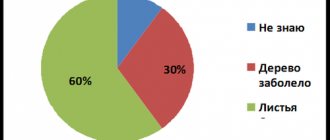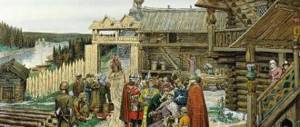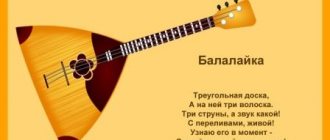Russian folk riddles
| Make yourself crazy in summer, make you wise in winter. Plow Where the water stands in a column and does not spill? In the well |
What do they hammer the nail into? In a hat
There is a hut without coal, people live in it without fear. Hive
Face to the wall, And back to the hut Ax
It’s heavy, not heavy, but you can’t throw it over the hut. Feather
One father, one mother, And neither one nor the other is a son? Daughter
My dear friend and friend The chairman of the tea trust: In the evening he treats the whole family to tea. He is a stout and strong guy: He swallows chips without harm. Although he is small in stature, he puffs like a steam engine. Samovar
There is a hole in the sky, a hole in the ground, and in the middle there is fire and water. Samovar
Hands on hips, like a boss, He gets up on the table before everyone else, He makes his own stove and the kettle - He brews it himself, pours it himself. Samovar
Two brothers quarrel - They won’t argue, They fight with each other - They won’t separate Millstones
Two godfathers of Abakum, two godfathers of Avdotya, six Faleleev, and nine Andreyev. Sled
Both you and us have a pig stuck in Klin
The ankle shakes, it is easy to bow. Axe
I will stand, so above the horse, And I will lie down, so below the cat Rocker
The chicken is on the chicken, And the little Russian is on the street. Izba
Here is Asya, lying down, If only she could stand up, If only she could reach the sky! If only she could tie the thief’s hands, If only she could catch up with the horse’s legs, If only she could see her eyes! As if the language - told! Road
They run without legs, They scream without mouths, They don’t know the road, And the others are seen off by Skids
Why can’t you surround the hut? Water in a sieve
There is a bychishche, the casks are pecked out Izba
What can’t you get kicked out of the hut? Dust
A stick through the wall. Suchek
A goat is lying in a hut. And the horns are in the yard. Matica
A hundred guests, a hundred beds, Everyone has felt. Logs and moss
Selected horses stand in a field on Romanov, drink rainwater, eat marsh grass. Logs and moss
He doesn't walk, he walks. It walks on the same runner day and night. Door in the hut
Two walk, two wander. The two will come together and kiss. Swing door
What is there in the world that is more violent? Wind and water
What's not faster? Eyes
Little black cow, iron horns, That’s why it’s useful; In winter, a day twice a day, Summer milks once on a pebble, Intermilk does not go. Flint
He slept in stone, stood up on iron, walked on wood like a falcon flew. Fire
I am not on my own, but the strongest and the most terrible, and everyone loves me, and everyone is destroying me. Fire
What does each village stand on? On a righteous man
The ram is in the barn, And the horns are in the wall Brace
A little boy is looking at everyone's feet. Threshold
It stands like a pillar, burning with fire; No heat, no steam, no coals. Candle
Turchen flies to the storbuchen and shtrukh into the hole. Lock and key
A little red cockerel is running down the street. Fire
I’ll put it in a golden bowl, I’ll beat it there and turn it back. Poker
A black hen sits on red eggs. Bowler
The black sheep is all on fire. Trivet
Three legs, two ears, and a sixth belly. Lohan
Not sewn, not cut, but covered in scars. Felt boots
Without arms, without legs, leaning in all directions. Zybka
I was at the kopanets, I was at the khlopanets, I was at the fire, I was at the bazaar; I was young - I fed people, I became old - I began to swaddle, I died - my scoundrel bones were thrown into a hole, and the dogs do not gnaw. Pot
I was at the market and found myself on fire. Pot in the oven
There is a mountain, in the horn there is a hole, in the hole there is a beetle, in the beetle there is water. Furnace and boiler
Little pot-bellied one. And he protects the whole house. Lock
What can’t you get out of the hut? Bake
In winter there is no warmer, in summer there is no colder Stove
Yaga stands with horns on his forehead. Stove and Voronets
There's a bear's paw under our bench. Log
The little black dog lies curled up; Doesn't bark, doesn't bite. But the Castle won't let you into the house
Neither the light nor the dawn went, Bent over from the yard Rocker
Two brothers want to fight, but the arms are short Rocker
Two jackdaws sit on one stick Buckets and a rocker
Two are bathing, the third is lying around; Two came out, the third hung Buckets and a yoke
Forty floor - one hem Roof
I dragged a gut through the ceiling. Pipe on the roof
How much have you lived in your belly? 9 months
Where are the water and the horns? Where does the cow drink?
What can produce good and evil? Money
An old man walked with a boy. They asked the boy: What kind of relatives are you, old man? He answered: His mother is my mother’s mother-in-law. What kind of family is this? Uncle
She is not a bird, She does not sing, Whoever goes to the owner - She lets him know. Dog
I’ll go out on a prank, I’ll beckon to the little one, A jacket will run towards me. Hen and chicks
The king walks around the city, wears honor on his head. Rooster
Pan Panoval fell into the water, but did not muddy the water. Sheet
I will go out into the forest without an ax, without a chisel, I will carve two sled boats, two floorboards, a tire for a pot, a handle for a ladle. Acorn
In our hut the grandmothers are red. Spoons
The cow is in the stable, and the tail is in the stable. Spoon in a cup
Without arms, without legs - he crumbles noodles. Knife
The body is lying there: the head is missing, but the throat is intact. Shtof
Never eats, but only drinks; And when it makes noise, the Samovar calls everyone together
What is sweeter in the world? Bread and salt
Little dark girl, she ran all over the field and had lunch with the king. Pepper
I’ll take the dusty one, I’ll make it liquid; If I throw it into the fire, it will be like a stone. Pie
Sits on a spoon, all legs noodles
On the Nogai field, On the Tatar border, there are chiseled pillars, gilded heads. Rye
Stooped, hunchbacked, with a gag on the front. The whole field will be afforested, He will come home, He will walk through the cracks. Sickle
She is long, her nose is long, and her hands are small. Scythe
It won't eat as much as it will trample. Mortar
Baba Yaga stands, her leg is cut open, she feeds the whole world, she herself is hungry. Sokha
The old man is on the mountain, And the old woman is under the mountain; The old man held on, held on, and clung to the old woman. Burdock
Between the mountains, between the pits sits the bird Kholuyan, lays eggs - a gift from God. Potato
There is a town on the tychina, There are seven hundred governors in it. Poppy
What animal was not in Noah's Ark? Fish
Knocks, spins, is not afraid of the fear of God; It is our age that counts, not man. Clock on the wall
Why can’t you put it to the hut? Way to go
What is more expensive in the world? Friend
I do the same job day and night. I breathe
Partially taken from the site https://presspull.ru
LiveInternetLiveInternet
The Dymkovo toy is a symbol of the Kirov region, emphasizing its rich and ancient history. It is molded from clay, then dried and fired in a kiln. After that, it is painted by hand, each time creating a unique copy. There cannot be two identical toys. Zhostovo painting
At the beginning of the 19th century, the Vishnyakov brothers lived in one of the Moscow villages of the former Troitskaya volost (now Mytishchi district), and they were engaged in painting lacquered metal trays, sugar bowls, pallets, papier-mâché boxes, cigarette cases, teapots, albums and other things. Since then, artistic painting in the Zhostovo style has begun to gain popularity and attract attention at numerous exhibitions in our country and abroad. Khokhloma
Khokhloma is one of the most beautiful Russian crafts, which originated in the 17th century near Nizhny Novgorod. This is a decorative painting of furniture and wooden utensils, which is loved not only by connoisseurs of Russian antiquity, but also by residents of foreign countries. The intricately intertwined herbal patterns of bright scarlet berries and golden leaves on a black background can be admired endlessly. Therefore, even traditional wooden spoons, presented on the most insignificant occasion, leave the recipient with the kindest and longest memory of the donor.
Gorodets painting
Gorodets painting has existed since the mid-19th century. Bright, laconic patterns reflect genre scenes, figurines of horses, roosters, and floral patterns. The painting is done in a free stroke with a white and black graphic outline; it decorates spinning wheels, furniture, shutters, and doors. Ural malachite
Known deposits of malachite are in the Urals, Africa, South Australia and the USA, but in terms of color and beauty of patterns, malachite from foreign countries cannot be compared with that from the Urals. Therefore, malachite from the Urals is considered the most valuable on the world market. Gusev crystal
Products made at the Gus-Khrustalny crystal factory can be found in museums all over the world. Traditional Russian souvenirs, household items, sets for the festive table, elegant jewelry, boxes, and handmade figurines reflect the beauty of our native nature, its customs and primordially Russian values. Products made from colored crystal are especially popular. Matryoshka
A chubby and plump cheerful girl in a headscarf and Russian folk dress won the hearts of lovers of folk toys and beautiful souvenirs around the world. Nowadays, the nesting doll is not just a folk toy, a keeper of Russian culture: it is a memorable souvenir for tourists, on the apron of which play scenes, fairy tale plots and landscapes with attractions are finely drawn. The nesting doll has become a precious collectible that can cost hundreds of dollars. Enamel
Vintage brooches, bracelets, pendants, which quickly “entered” modern fashion, are nothing more than jewelry made using the enamel technique. This type of applied art originated in the 17th century in the Vologda region. Masters depicted floral patterns, birds, and animals on white enamel using a variety of paints. Then the art of multi-color enamel began to be lost, and monochromatic enamel began to supplant it: white, blue and green. Now both styles are successfully combined. Tula samovar
In his free time, Fyodor Lisitsyn, an employee of the Tula Arms Factory, loved to make something out of copper, and once made a samovar. Then his sons opened a samovar establishment where they sold copper products, which were wildly successful. The Lisitsyn samovars were famous for their variety of shapes and finishes: barrels, vases with chasing and engraving, egg-shaped samovars, with dolphin-shaped taps, with loop-shaped handles, and painted ones. Palekh miniature
Palekh miniature is a special, subtle, poetic vision of the world, which is characteristic of Russian folk beliefs and songs. The painting uses brown-orange and bluish-green tones. Palekh painting has no analogues in the whole world. It is done on papier-mâché and only then transferred to the surface of boxes of various shapes and sizes. Gzhel
The Gzhel bush, an area of 27 villages located near Moscow, is famous for its clay, which has been mined here since the mid-17th century. In the 19th century, Gzhel craftsmen began to produce semi-faience, earthenware and porcelain. Of particular interest are still items painted in one color - blue overglaze paint applied with a brush, with graphic detailing. Pavlovo Posad shawls
Bright and light, feminine Pavloposad shawls are always fashionable and relevant. This folk craft appeared at the end of the 18th century at a peasant enterprise in the village of Pavlovo, from which a shawl manufactory subsequently developed. It produced woolen shawls with printed patterns, which were very popular at that time. Nowadays, original designs are complemented by various elements such as fringe, are created in different colors and remain an excellent accessory to almost any look. Vologda lace
Vologda lace is woven on wooden sticks and bobbins. All images are made with dense, continuous, uniform width, smoothly curling linen braid. They stand out clearly against the background of patterned lattices, decorated with elements in the form of stars and rosettes. Shemogodskaya carved birch bark
Shemogodskaya carving is a traditional Russian folk art craft of birch bark carving. The ornaments of Shemogod carvers are called “birch bark lace” and are used in the manufacture of boxes, teapots, pencil cases, cases, dishes, plates, and cigarette cases. The symmetrical pattern of Shemogod carving consists of floral patterns, circles, rhombuses, and ovals. The drawing can include images of birds or animals, architectural motifs, and sometimes even scenes of walking in the garden and drinking tea. Tula gingerbread
Tula gingerbread is a Russian delicacy. Without these sweet and fragrant products, not a single event took place in Rus' - neither funny nor sad. Gingerbread was served both at the royal table and at the peasant table. The traditional shape is given to the gingerbread using a board with a carved ornament. Orenburg downy shawl
The scarves are knitted from natural goat down and are amazingly soft, beautiful, warm and practical. Openwork web scarves are so thin and elegant that they can be threaded through a wedding ring. They are valued by women all over the world and are considered a wonderful gift.
https://davaipogovorim.mirtesen.ru/blog/43698712865...ov-narodnogo-iskusstva-Rossii.


